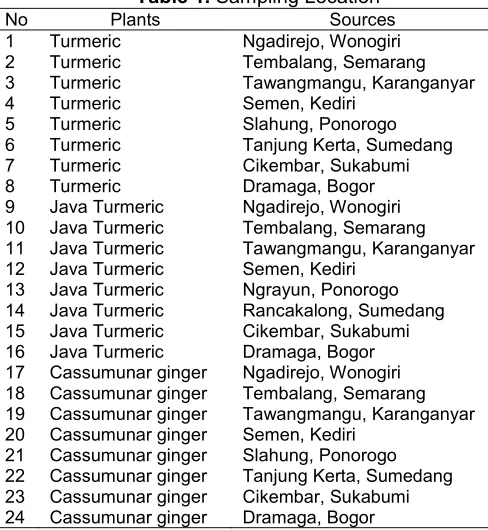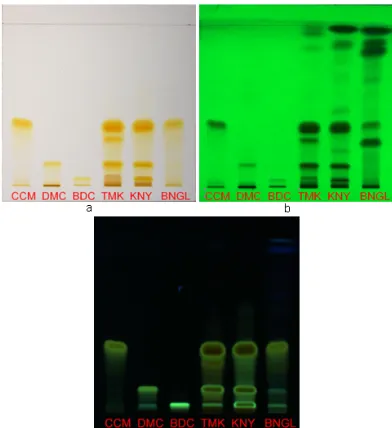Indo. J. Chem., 2011, 11 (1), 71 - 74
Mohamad Rafi et al.
71
* Corresponding author. Tel/Fax : +62-251-8628766/8624567 Email address : [email protected]
DIFFERENTIATION OF
Curcuma longa
,
Curcuma xanthorrhiza
and
Zingiber cassumunar
BY THIN LAYER CHROMATOGRAPHY FINGERPRINT ANALYSIS
Mohamad Rafi
1.2.*, Eti Rohaeti
1, Ali Miftahudin
1, and Latifah K. Darusman
1.2 1Department of Chemistry, Faculty of Mathematics and Natural Sciences, Bogor Agricultural University, Kampus IPB Dramaga, Bogor, Indonesia
2
Biopharmaca Research Center, Institute of Research and Community Empowerment, Bogor Agricultural University, Kampus IPB Taman Kencana, Bogor, Indonesia
Received September 20, 2010; Accepted November 5, 2010
ABSTRACT
Turmeric (Curcuma longa), java turmeric (Curcuma xanthorrhiza) and cassumunar ginger (Zingiber cassumunar) are widely used in traditional Indonesian medicine. These three herbs have relatively similar rhizomes colour so it is difficult to be differentiated especially if they are in powder form. A rapid and reliable method, thin layer chromatography (TLC) fingerprint, has been developed in order to identify, authenticate and differentiate these three herbs through fingerprint profile of chemical compounds. TLC fingerprints of the three herbs were obtained by visualization of separate zones with visible and UV (254 and 366 nm) light. The TLC fingerprint pattern is different each other and showed a specific marker zones respectively. Therefore, TLC fingerprint can be utilized for identification, authentication and differentiation method in quality control of the three herbs tested.
Keywords:Curcuma longa, Curcuma xanthorrhiza, Zingiber cassumunar, TLC fingerprint, quality control
INTRODUCTION
The Rhizomes of turmeric (Curcuma longa), java turmeric (Curcuma xanthorrhiza) and cassumunar ginger (Zingiber cassumunar) are widely used in Indonesian traditional medicine (jamu). These three rhizomes are generally having a yellow or orange color due to the present of curcuminoids. Physically, to differentiate these three rhizomes is not difficult but it’s become more difficult if they are pulverized as powder or cut into slice. In Indonesia herb market, the price of java turmeric is normally 3-5 times higher than turmeric and cassumunar ginger. This is one of the reasons why especially turmeric sometimes is found as adulterants of java turmeric. Therefore, an accurate analytical method is essentially required for the identification, authentication and differentiation of these herbs to ensure the safety, quality, and consistency of their products.
The components in herbal medicines are the basis of medical efficacy, while the variation in content and components could makes the variation efficacy stability. Furthermore, this condition will cause the quality control more difficult. Since the efficacy of herbal medicines depends on the synergestic action many components, the contents of part compounds can not represent its integral quality. So the methods of quality control should depend on the utilization of information on all components to evaluate the quality of herbal medicines [1]. Recently, chromatographic fingerprint analysis has been attracting more people’s attention and accepted by
the World Health Organization (WHO) [2]. Chromatographic fingerprint is a sufficient-used method in profiling the overall compound because the retention factor which represents the characteristics of component will represent the complexity of the analyte in the sample. Thin Layer Chromatography (TLC) is frequently used to obtain a fingerprint profile of the compounds that present in herbal medicines and its derivative products.
Indo. J. Chem., 2011, 11 (1), 71 - 74
Mohamad Rafi et al.
72
EXPERIMENTAL SECTION
Materials
Samples of turmeric, java turmeric and cassumunar ginger were collected from 8 locations in Java Island (Table 1) and voucher specimen of all samples was deposited in Biopharmaca Research Center-Bogor Agricultural University. Curcumin, demethoxycurcumin and bisdemethoxycurcumin were kindly donated from Prof. J.K. Hwang (Yonsei University, South Korea). Silica gel 60 F254 TLC plates (Darmstadt,
Germany) were used for TLC fingerprint analysis. All solvents used were analytical grade and obtained from Merck or Sigma-Aldrich (St. Louis, USA).
Instrumentation
TLC fingerprint was carried out using semiautomated TLC system including semi-automatic TLC sampler Linomat IV(connected to a nitrogen tank), flat bottom chamber and documentation device Reprostar 3 with winCATS version 1.2.3. planar chromatography manager software (CAMAG, Muttenz, Switzerland).
Procedure
Sample and Standard Preparation
The powdered samples were extracted using ethanol by maceration according to the method described in Monograph Extract of Indonesian Medicinal Plant Volume 1 [11] and repeated three times to maximize extraction efficiency. The extracts were filtered (Whatman No. 2) and concentrated under vacuum at 30 °C using a rotary evaporator (Büchi, Switzerland). The dried extracts were dissolved in ethanol with a final concentration of 1000 µg/mL prior to TLC fingerprint analysis. Standard solutions were prepared by dissolving
curcurmin, demethoxycurcumin and
bisdemethoxycurcumin in ethanol with a final concentration of 100 µg/mL.
TLC Fingerprint Analysis
Sample and standard solutions were applied to plates using TLC semiautomatic sampler Linomat IV with application volume of 10 µL. Temperature and humidity were not controlled via the TLC system but the experiments were carried out in a temperature controlled laboratory. Plates were developed with chloroform-dichloromethane (32.5:67.5 v/v) in a flat bottom chamber previously saturated with the mobile phase. After developing over a path of 80 mm, the plate was air-dried. To visualize the chromatogram, plate were documented
Table 1.Sampling Location
No Plants Sources
1 Turmeric Ngadirejo, Wonogiri
2 Turmeric Tembalang, Semarang
3 Turmeric Tawangmangu, Karanganyar
4 Turmeric Semen, Kediri
5 Turmeric Slahung, Ponorogo
6 Turmeric Tanjung Kerta, Sumedang
7 Turmeric Cikembar, Sukabumi
8 Turmeric Dramaga, Bogor
9 Java Turmeric Ngadirejo, Wonogiri
10 Java Turmeric Tembalang, Semarang
11 Java Turmeric Tawangmangu, Karanganyar
12 Java Turmeric Semen, Kediri
13 Java Turmeric Ngrayun, Ponorogo
14 Java Turmeric Rancakalong, Sumedang
15 Java Turmeric Cikembar, Sukabumi
16 Java Turmeric Dramaga, Bogor
17 Cassumunar ginger Ngadirejo, Wonogiri
18 Cassumunar ginger Tembalang, Semarang
19 Cassumunar ginger Tawangmangu, Karanganyar
20 Cassumunar ginger Semen, Kediri 21 Cassumunar ginger Slahung, Ponorogo 22 Cassumunar ginger Tanjung Kerta, Sumedang 23 Cassumunar ginger Cikembar, Sukabumi
24 Cassumunar ginger Dramaga, Bogor
and evaluated underUV (254 and 366 nm) and visible light.
RESULT AND DISCUSSION
Differentiation of closely related medicinal plants is very important to carry out for identification and authentication the raw materials of herbal medicines in order to prevent adulteration in the herbal medicines industry. Turmeric, java turmeric and cassumunar ginger is closely related species belongs to the Zingiberaceae family, so, they have similarity on the appearance especially in powdered form and chemicals composition but posses different pharmacological activities, so it can be sources for adulteration in the herbal medicines product containing one of these three rhizomes. TLC fingerprint analysis is one of the techniques frequently used for evaluation the quality of herbal medicines. This technique commonly used for identification, differentiation and authentication of raw and extract of herbal medicines [12].
Chromatographic conditions such as the mobile phase (solvent and ratio) have been optimized firstly before applied to all samples from different locations. TLC fingerprint analysis for all samples used was made using silica gel 60 F254 as a stationary phase and
Indo. J. Chem., 2011, 11 (1), 71 - 74
Mohamad Rafi et al.
73
Fig 1. TLC fingerprints of turmeric, java turmeric and cassumunar ginger with visualization on visible light (a), UV 254 nm (b), and UV 366 nm (c)
Note: CCM = Curcumin ; DMC = Demethoxycurcumin; BDC = Bisdemethoxycurcumin; TMK = Java turmeric; KNY = Turmeric; BNGL = Cassumunar ginger
Fig 2. TLC fingerprints turmeric (a), java turmeric (b), and cassumunar ginger (c) with visualization on UV 254 nm.
Note: STD = mixed standard solution of curcuminoids (bisdemethoxycurcumin, demethoxycurcumin, and curcumin); NGD = Ngadirejo, Wonogiri; TMB = Tembalang, Semarang; TWN = Tawangmangu, Karanganyar; SMN = Semen, Kediri; SLH = Slahung, Ponorogo; NGR =Ngrayun, Ponorogo; TJK = Tanjung Kerta, Sumedang; RCK = Rancakalong, Sumedang; CKR = Cikembar, Sukabumi; DMG = Dramaga, Bogor
366 nm) and visible light. According to the fingerprint chromatogram obtained (Fig. 1) we can identify, differentiate and verify the authenticity of the herbs tested with a marker zones which only appeared in one herb.
Fig. 1 displays fingerprint chromatograms for turmeric, java turmeric and cassumunar ginger viewed under UV (254 and 366 nm) and visible light. Fingerprint patterns of the three herbs tested are significantly different in the number of zones appear and Rf values. Turmeric is characterized by 7 absorbed zones at a range of Rf 0.05–0.97 under UV 254 nm with 5 of them (Rf 0.05, 0.14, 0.37, 0.88 and 0.97) give strong absorption. With UV 366 nm, 3 sharpe brown-yellow fluorescent zones at a range of Rf 0.05–0.37 are detectable. Under visible light, only 3 yellow zones at Rf 0.05, 0.14 and 0.37 were observed. The fingerprint pattern of java turmeric under UV 254 nm clearly showed 4 strong and 3 weak absorbed zones at a range of Rf 0.05–0.37 and 0.86–0.97, respectively. Detection at UV 366 nm, 2 sharp brown-yellow fluorescent zones (Rf 0.14 and 0.37) and 1 yellow fluorescent zone (Rf 0.05) were observed. Between those zones, a brown fluorescent zone at Rf 0.29 is present. Observing the plate under visible light, it showed 4 yellow zones at Rf 0.05, 0.14, 0.28 and 0.37, respectively. The TLC fingerprints of cassumunar ginger give 5 strong absorbed zones at a range of Rf 0.27–0.97 and a weak absorbed zones at Rf 0.66 under UV 254 nm. Three yellow zones appear at a range of Rf 0.05–0.37 and two blue fluorescent zones at the Rf 0.89 and 0.97 are detectable with UV 366 nm. Visualization with a visible light detection only 1 sharp yellow zone at Rf 0.37 as well as 2 slightly yellow zones at Rf 0.14 and 0.37 are appeared. The Rf values corresponding to 0.05, 0.14 and 0.37 represent
curcumin, demethoxycurcumin, and
bisdemethoxycurcumin, respectively. From this result, visualization on UV 254 nm gives more detectable component compared to the UV 366 nm and visible light. So this mode of detection was chosen for differentiation of the three herbs tested.
Indo. J. Chem., 2011, 11 (1), 71 - 74
Mohamad Rafi et al.
74
by choosing those selected marker zones from the TLC fingerprints obtained.
CONCLUSION
In this work, TLC fingerprints with a stationary phase from silica gel 60 F254, mobile phase
chloroform-dichloromethane (32.5:67.5) and detection of zone using UV 254 nm were adequate for differentiation of turmeric, java turmeric and cassumunar ginger. This quality control method could be used for identification and authentication purposes by regulatory authority or jamu
industry in order to prevent adulteration in herbal medicines.
ACKNOWLEDGEMENT
This work was supported by the Fundamental Research Grant number 45/13.24.4/SPK/B6-PD/2009 from the Directorate General of Higher Education, the Ministry of National Education Republic Indonesia.
REFERENCES
1. Soares, P.K., and Scarminio, I.S., 2008,
Phytochem. Anal.,19, 1, 78–85.
2. Zhao, L., Huang, C., Shan, Z., Xiang, B., and Mei, L., 2005,J. Chromatogr. B, 821, 1, 67–74.
3. Schibli, A., and Reich, E., 2005, J. Planar. Chromatogr. - Mod. TLC, 18, 1, 34–38.
4. Koll, K., Reich, E., Blatter, A., and Veit, M., 2003,
J. AOAC Int., 86, 5, 909–915.
5. Chen, S.B., Liu, H.P., Tian, R.T., Yang, D.J., Chen, S.L., Xu, H.X., Chan, A.S.C., and Xie, P.S., 2006,J. Chromatogr. A, 1121, 114–119.
6. Cimpoiu, C., Hosu, A., Briciu, R., Miclaus, V., 2007, J. Planar. Chromatogr. - Mod. TLC, 20, 6, 407–410.
7. Liu, X.Q., Du, L.L., Li, W.W., Guan, H.F., and Liu, F., 2008,Chem. Pharm. Bull., 56, 175, 75–78. 8. Ankli, A., Reich, E., and Steiner, M., 2008, J.
AOAC Int., 91, 6, 1257–1264.
9. Widmer, V., Reich, E., and deBatt, A., 2008, J. Planar. Chromatogr. - Mod. TLC, 21, 21–26. 10. Vermaak, I., Hamman, J.H., and Viljoen, A.M.,
2009,S. Afr. J. Bot., 76, 119–124.
11. Badan Pengawas Obat dan Makanan RI., 2005,
Monografi Ekstrak Tumbuhan Obat Indonesia Volume 1, Badan Pengawas Obat dan Makanan RI, Jakarta,
12. Jiang, Y., David, B., Tu, P., and Barbin, Y., 2010,

